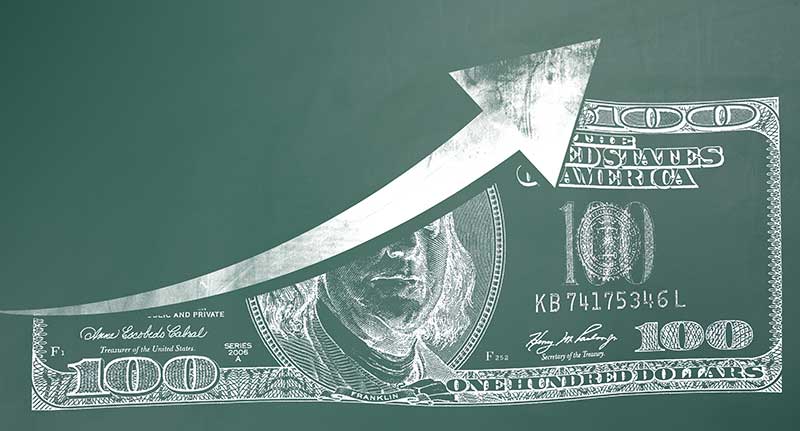
The Inflation Saga
BY JOSEPH AMATO
Inflation, defined as the general increase in prices and the corresponding decrease in the purchasing power of money, is measured by indexes like the Consumer Price Index (CPI) or the Producer Price Index (PPI), which tracks the price of goods and services over a fixed period of time. While moderate inflation indicates a growing economy, high or hyperinflation can lead to many economic challenges.
Our goal is to explore the different effects of inflation on individuals, businesses, and the government and to examine the broader micro- and macroeconomic impact of inflationary activities.
Inflation affects consumers primarily by reducing an individual’s purchasing power. As the price of goods and services increases, consumers are forced to spend more for the same items they purchased at a lesser price in a previous period, reducing their disposable income. If inflation rises by 5% and wages don’t increase at the same rate, consumers are effectively poorer. This situation is particularly detrimental to individuals on fixed incomes, such as retirees, whose purchasing power erodes significantly over time if inflation persists.
Inflation can also lead to price instability, where businesses such as most restaurants or manufacturers must always seek to update their price schedules to absorb the additional costs of food or raw materials. This affects consumers indirectly through higher costs of goods, as most businesses must pass these costs onto the consumer to survive. Inflation also leads to varied levels of uncertainty, causing consumers to delay major purchases, such as homes, cars or major appliances, as they hope that eventually prices will stabilize or fall.
Inflation, most importantly, tends to have a negative impact on savings. When inflation rates exceed interest rates on savings accounts, the real value of savings decreases, and the opportunity or incentive to save is reduced dramatically. If the inflation rate is upwards of 5% and the interest rate on a savings account is 2%, the purchasing power of the money in that account declines by 3% annually. This discourages savings and pushes individuals toward investment vehicles that provide higher returns, such as stocks or real estate, if those avenues are even attainable for the average middle-class consumer.
For investors, inflation erodes the real return on investments. If an investor receives a 7% return on stocks but inflation is 5%, the real return is only 2%. Bonds are particularly vulnerable to inflation since they provide fixed interest payments. As inflation rises, the real value of these payments decrease, making bonds less attractive compared to other investments.
For the average business, inflation affects the cost of goods and raw materials as well as the corresponding revenues. Higher inflation costs for raw materials, wages and transportation, among others, can affect a business owner’s capacity to operate profitably if high prices don’t drive the business into losses that can’t be overcome. A business must pass higher costs onto consumers through price increases to maintain profit margins. Consequently, if a business increases its prices too much, it risks losing customers to competitors, especially in highly competitive industries.
Some businesses may benefit from inflation in the short term if they can raise prices faster than their costs increase, but long-term inflation can cause other disruptions. High inflation leads to salary and wage renegotiations and reduced consumer spending, ultimately leading to a profit loss.
Inflation can have an inverse impact on the banking sector, while it affects borrowers and lenders differently. Borrowers may, for the short term, benefit from inflation because it reduces the real value of their debt. This is especially true if an individual takes out a loan or mortgage with a fixed interest rate and inflation rises. In this scenario, they effectively pay back less in real terms than they borrowed.
On the other hand, lenders are hurt by inflation because the money they’re repaid is worth less than when they originally lent it. As a result, lenders will normally demand higher interest rates during periods of high inflation, if possible, to compensate for the reduced purchasing power on the money they will receive in the future. Lenders would love to stay in a variable rate environment on their longer-term loans and mortgages to offset any inflationary effects on their loan portfolio.
Now for the most important consequence of inflation and its impact on the macro-economy. The most important effect is on interest rates. Central banks like the Federal Reserve System (the “Fed”) in the United States want to raise interest rates to curb inflation. Higher interest rates increase the cost of borrowing, reducing consumer spending and business investment, leading to slower economic growth. The problem is that this methodology worked well in the 80s and 90s when raising interest rates could affect the “money” markets. The problem today is that the vast increase in the use of digital currency has dampened the effect of rising interest rates to curb inflation, and the Fed has had an issue reconciling its actions with the realities of global economic and monetary systems shifting to digital currencies.
Digital currencies like Bitcoin or NFTs have been touted as a hedge against inflation. This perspective sees digital currencies as similar to gold, which has historically served as a premium commodity when fiat currencies lose purchasing power due to inflation. The idea is that unlike fiat currencies, which can be printed in unlimited quantities by governments, digital currencies have a fixed supply, potentially maintaining their value as fiat currencies depreciate due to inflation.
Persistent high inflation can also lead to “hyperinflation,” where prices increase uncontrollably. This can result in the collapse of a currency and severe economic instability, as was seen in countries like Zimbabwe and Venezuela, where the currency couldn’t keep up with the demand for scarce products and services.
Inflation can also impact trade balances. If a country experiences higher inflation than its trading partners, its goods and services become more expensive, reducing export demand. Meanwhile, imports from countries with lower inflation become cheaper, which can ultimately result in a trading deficit.

Governments often need help managing inflation because the federal policies meant to control inflation can conflict with other economic goals. The U.S. government depends on the Fed to raise interest rates to control inflation. As a result, these actions could lead to a slowdown in economic growth and, therefore, an increase in unemployment. Sadly, in the past few years, the U.S. government implemented programs and “politically oriented” giveaways that drastically increased public spending during the current inflationary period and garnered public support in a political season. However, these measures exacerbated and extended the inflationary period in the economy.
Additionally, the effects of inflation will certainly impact government budgets through increased costs of public services and infrastructure. As inflation rises, the government must spend more on everything from healthcare to defense. This leads to larger budget deficits, increased borrowing, and the printing of more cash into the economy, which can further fuel inflation in the long run.
Inflation has far-reaching effects on both microeconomic and macroeconomic levels. For individuals, it erodes purchasing power and savings; it increases costs and complicates pricing strategies for businesses. Borrowers may benefit from inflation in the short term, but lenders rarely lose out in the long run. Inflation will affect interest rates dramatically, and government policies and economic outlook will lead to policy shifts, unending blame between the politicos for their self-interests, and, ultimately, a reduction in services and available goods for the consumer. While moderate inflation may be a valuable sign of a healthy, growing economy, excessive inflation can result in uncertainty, reduced economic growth and, in extreme cases, economic collapse. Managing inflation is one of the central challenges for government policymakers, market makers and forward-thinking major business groups and influencers who aim to ensure economic stability and sustainable growth in the future.
It’s certain and proven over 100 years that our economy runs unpredictably. There will always be periods of vast economic growth and strong headwinds like inflation, war, corruption and bad economic policies that can cause a thriving economy torment and despair. The consumer is primarily along for the economic ride, and often, they’re very susceptible to these economic changes that occur beyond their control. How anyone survives is purely subject to planning for the worse and hoping for the best. Not the best advice, but with some of the knowledge shared here, there may be both insight and opportunity for better days ahead.


